Lea Wait's Blog, page 285
July 30, 2015
Gutting it out in a Funky Summer

Larry’s recently rehabbed garden
John Clark slowly recovering from a hernia repair. I had one fixed back in 1981 and I can tell you, my body at 67 sure doesn’t bounce back like it did at age 33. As things stand, I’m not allowed to lift anything heavier than 10 pounds for six weeks and can’t drive for at least one more week. Boxes of books sneer as I waddle past and I can hear the back lawn giggling every time it rains.
Each time I’m tempted to do something stupid, I remember what happened the day I got out of the hospital back when the first one was repaired. I hadn’t planned on fruit trees arriving at an inopportune time when I was diagnosed and surgery was scheduled, so imagine my chagrin (yes liberals were allowed to possess up to 8 ounces of chagrin in the early 1980s) when the UPS driver backed into the driveway and handed me a long box. If I’d had any common sense, I would have thought of someone I could call and ask to plant the trees, but that wasn’t in the cards, so I grabbed a shovel and started digging. I wasn’t down more than six inches when I felt a pop and a burning sensation. Fortunately, it was only one stitch, but that was enough to convince me to be ultra careful as I finished excavating three holes for the new trees. My folly resulted in no permanent damage and there was an unexpected bright side to the whole hernia experience. I ended up being out of work for seven weeks and it was a real eye-opener. I’d started working regularly at age eleven, mostly in the blueberry fields, but in a neighbor’s poultry barn as well. Until the forced medical leave, I’d pretty much been a workaholic. To realize that there was life outside of the workplace was a complete amazement and altered my outlook significantly.

Morning Glory vines on their way to hiding the mailbox
Times have changed in terms of what’s done and how they do it. This time around, it was day surgery and involved three small incisions and a miniature camera wandering around my belly, followed by the sewing into place of a mesh screen and then having the incisions glued with a variation on the super glue we use to repair household items. Even so, that was a week ago and I’m still bent over and trying not to hobble a lot. Fortunately the post office, the library and the grocery store are two blocks away, but the recent spate of rainstorms washed a lot of mud down to the edge of the sidewalk, particularly in sloped driveways. Yesterday, I was about to say hello to some young veggie salesmen who were selling garden goodies down the street when my foot hit some of the really slippery mud. Next thing I knew, I was doing my James Bond martini imitation—shaken, but not stirred. All I could think about as I desperately tried to maintain my balance was ‘hope to hell I don’t pop anything.”

Partial view of our raised bed
On to a garden status report. Last year, Brenda Seekins who is a local master gardener, asked about having an informal gathering at the library of people interested in sharing garden wisdom, seeds, plants while getting answers and inspiration. We met four times and developed a core group. In October, we agreed at the final meeting to resume in April of 2015. The group had our third meeting last night. Even though we all live within a four mile radius, what has happened to our gardens this summer shows some significant variation. Before I get into those, let me backtrack and share some of the things I’ve heard in my travels and conversations during the growing season. It started with a chat I had with a man in Detroit who sells hay and straw. He also grows plants for seed purposes for a Maine company. He said that the month of June was the worst he could remember in terms of growing weather. It was too cold and too wet, causing seed rot and real difficulty getting into his fields to plant.

Zuke, Zuke, Zuke of Earl
His observations were mirrored in a conversation I had a couple weeks later with a friend from Canaan who is an organic gardener. He went even further, noting that even stuff in hoop houses wasn’t growing very well thanks to the chill. The next piece of information came from Joe, the man who services our furnace. We were talking about picking strawberries and he noted that his wife had gone to a nearby pick your own place a couple days earlier and when she returned, she said the owners had told her that last winter was extremely hard on strawberry plants, resulting in significant winter kill. This was reinforced when it took me almost a week to find a day when Sites Farm in Athens was open for picking. The berries were nice, but got picked out very quickly each morning. Before leaving the field, I checked out their high bush blueberries. From what I could see, there won’t be any shortage in that crop.

Beets (less 2 messes of greens) and carrots
Both people I encountered at the post office and those in the gardening group lamented the effect June’s cold and damp had on certain crops. Sweet corn has been a disaster for everyone in the group. I planted three times before giving up. I have two lone stalks and gave the rest of the row to a late planting of turnips. Zucchini and summer squash required a second planting before anything worthwhile showed above ground. Likewise for cucumbers and winter squash. While both came up, six weeks later, they’re sitting there looking dazed and nary a blossom is visible. Peas and green beans came in very spotty, necessitating a second planting in between what did come up, but both are now healthy and close to being ready for picking. After discovering an almost full packet of yellow bean seeds, I planted them in mid-July and it looks like every seed germinated overnight.

Our two lonely cornstalks and the row of turnips that replaced the ones that didn’t make it.
Beets, carrots, parsnips and broccoli all did well from seed, but four very hungry woodchucks decimated the red and green cabbage as well as all but one of our cauliflower. While we have yet to see a single deer track, folks on the other side of the Sebasticook river here in Hartland, can’t keep them out of garden spots. Unlike several people I’ve talked to, who all bemoaned the terrible luck they were having with tomatoes, our five varieties are not only thriving, but have been producing ripe fruit for a couple weeks. Finally, I’m very happy to report that there are fruit clusters on the grape vines and we’ve already picked two gallons of raspberries. While it’s still early, the apple crop also looks pretty promising.

Our lone cauliflower, soon to be at the heart of a steamy and cheesy affair.
Flowers, particularly perennials, seem to have an immunity to weather foibles. Our raised bed garden is a sea of color and the small garden my neighbor, Larry, let me rehabilitate (it had become a sea of milkweed, pigweed and crabgrass) will soon feature Tithona, morning glory, calendula and hollyhock in bloom. He was happy and it allowed me to find a home for extra plants. Larry also let me reclaim the vegetable garden behind his house that was sliding back into wilderness. It’s pretty eye-opening what a good zero-turn mower can do to a Maine jungle. Three hours of rototilling later and it was serviceable. I have a row of lettuce, some broccoli from seed and another 40 or so golden hubbard squash plants growing there. Potatoes and sunflowers I planted didn’t even give me the time of day. I’d be extremely interested in hearing what your gardening experiences have been this year.
 Peppers are always a conundrum. Last year huge leafy plants with no peppers. This year, small, but loaded they be.
Peppers are always a conundrum. Last year huge leafy plants with no peppers. This year, small, but loaded they be.
July 28, 2015
We Love Maine Mystery Writers
Our guest blogger today is Mainely Murders, a bookstore in Kennebunk that specializes in mysteries, talking about Maine crime writers who are popular with their patrons.
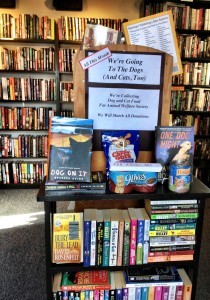 At Mainely Murders, our five-year-old mystery bookstore in Kennebunk, we love Maine crime writers. And, for the multitude who call Maine home (even for only part of the year), there’s a mystery for every taste—from the very cozy to the darkly noir.
At Mainely Murders, our five-year-old mystery bookstore in Kennebunk, we love Maine crime writers. And, for the multitude who call Maine home (even for only part of the year), there’s a mystery for every taste—from the very cozy to the darkly noir.
From the time we opened our doors (blood-red, of course), Maine mysteries have occupied a special place here—literally. Walk in, and there, just to the right of the door, are the shelves of Maine (and New England) writers. We also try very hard to have a strong backlist of these authors, and while we are primarily a used bookstore, we do sell new releases of our favorite authors.
While Maine books take up a relatively small part of our store, they are the first books that many summertime visitors head for when they enter. Whether looking for a title that will remind them of their vacation or eager to find a new (to them) writer, they often ask for recommendations. Because of the regional nature of much of the book business, some popular New England writers, for example, are virtually unknown elsewhere.
Indeed, unless their favorite writers and books top the New York Times Bestsellers list—or have inspired a made-for-TV movie or series—book buyers in general rely on recommendations. And our local customers are especially faithful to Maine writers once they learn about them.
This year, we’re focusing even more attention on Maine authors.
Now through September 15, those who purchase any book (new or used, hardback or 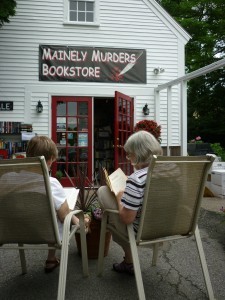 paper) by a Maine crime writer will be entered into our Maine mystery writers contest. No restrictions on how often can enter; one entry for each book purchased.
paper) by a Maine crime writer will be entered into our Maine mystery writers contest. No restrictions on how often can enter; one entry for each book purchased.
Since May, we’ve already well ahead of last year’s sales of books by Maine writers. But, the best news is that customers—both local and from away—have returned and asked for more.
So, who sells at Mainely Murders (keeping in mind that we maintain fairly extensive backlists of many authors?)
Beginning with The Poacher’s Son, readers have embraced Paul Doiron’s Mike Bowditch series. Last year, he was our best-selling Maine writer and ranked in the top 10 of all authors we carry. With each new book, he’s picked up new readers who invariably want to go back to the beginning and read them in order. For those who have followed him through Trespasser, Bad Little Falls, Massacre Pond, The Bone Orchard, and, now, The Precipice, there’s always the, “Call me when the next one comes out.”
Gerry Boyle’s Jack McMorrow books have been a favorite of mine since Deadline (1993), long before I became a mystery bookseller. A combination of a wonderfully clear, sharp writing style and a newspaper reporter protagonist—two clear-cut winners in my book—have made the McMorrow titles among my most highly recommended. (Thank you, thank you, Islandport Press, publisher of McMorrow #10, Once Burned, for its decision to reprint the earlier titles.)
Paul Doiron and Gerry Boyle share many readers. Mike Bowditch and Jack McMorrow aren’t that much different. Neither one is adverse to bending a few rules whether in Maine’s north woods, carrying a badge, or in its small towns, with a press pass.
On the distaff side, two of our favorite writers, Barbara Ross and Lea Wait, share readers in their new series. They also share a theme, young women returning home to Maine to save family businesses.
Customers who pick up the first of Barb Ross’ Maine Clambake Mysteries (Clammed Up) generally return for the two (Boiled Over and Musselled Out) that follow. We’re then happy to tell them Barb has signed a contract for three additional titles.
When Lea Wait, whose Shadow titles are very popular with our customers, published her first Mainely Needlepoint Mystery (Twisted Threads) this spring, our customers snatched it up. We now have a waiting list for her next two—Threads of Evidence (August 25) and Thread and Gone (December 29). We’re now delighted to share the news that she’s signed another three-book contract.
Others who consistently rank among our big sellers are John Connolly, Sarah Graves, Kate Flora, Kathy Lynn Emerson/Kristen Dunnett , Tess Gerritsen, B.B. Haywood, and Katherine Hall Page, especially her Sanpere Island stories.
Because we focus on used titles, supplemented by new releases, we generally have the backlist of least some, if not all, titles by many writers. (That holds true of our stock in general. While our small shop holds about 3,500 titles, our inventory of more than 10,000 books is accessible.)
One thing we’ve learned in the last five years is that big name authors don’t need booksellers like us hand selling their titles. If you’re wondering, I’ve never recommended a book by James Patterson, nor do I ever expect to.
What we will continue to do is introduce many wonderful Maine crime writers to readers both from here and away.
Mainely Murders Bookstore, owned by Paula Keeney and Ann Whetstone, is located at 1 Bourne Street, Kennebunk, ME 04043. To subscribe to our monthly e-mail newsletter, visit www.mainelymurders.com.
July 27, 2015
Steal This Idea!
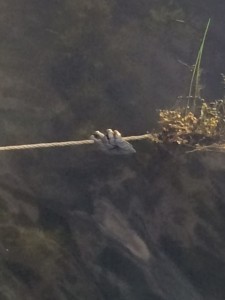
An escaped lobsterman’s glove, tangled in a rope. But doesn’t it look like more than that?
Kate Flora: Yesterday, Maureen Milliken wrote a post about the value of conversation to a writer. She’s so right. It’s impossible to underestimate the importance of talking to people in the know when you’re writing in a genre that requires detailed knowledge about the world of crime. As Maureen wrote, there are a lot of things we need to research in order to get them right, and we work in a genre where our readers are sharp, and quick to call us on it when we don’t do our research.
If you’ve been reading this blog for a while, though, you will know how I like to harp (oh, is that too negative a word or does harp put you in mind of lovely music?) on the subject of imagination. I’ve even taken my interest in prodding writers to use their imaginations as far as teaching a class for Grub Street from time to time called, “Imagine This.” Any student who has ever taken a class with me knows how often I urge those with a desire to write to pull out their earbuds, turn off their screens, and look at the world—and the people—around them to see the fabulous story ideas that are happening all around them all the time.
Once, years ago, I got the assignment to write the Afterword for a magazine. I decided to write about imagination, and since I was at one of those very cool parties that happen at conventions, with a room full of A-list writers, I decided to ask random people what came to mind when I used the word: Imagination. Far too many people reacted like it was a trick question, instead of saying: what we use all the time when we are writing.
This past weekend, I spent far too much time in my car dashing from one writerly event

The goofy blue chair I just finished putting together.
to another—events that were great fun, but which took me away from my writing desk, and the work that is calling to me. While I was driving, I was listening to NPR, and heard some interviews with E.L Doctorow, including this quote:
The thing about writing is that you use your imagination a good deal of the time and you can usually work out things by thinking about them and imagining them. That’s the whole game – to get into people’s skins, to pretend to be someone you’re not, to have experiences you’ve never had and to represent them truly to render them. E.L. Doctorow in an interview with Terry Gross on NPR
One of the things that happens when we look around, and let the things we see prod our imaginations, is we begin to ask the question: What is that about? Who is that about? What happened just before this? What is going to happen next?
For example, what is driving that chubby, heavily tattooed man in the diner in Falmouth to want to wear that ratty-looking semi-automatic weapon on his belt?
How did a folding chair, a sleeping bag, a beach towel, and assorted other gear come to be rolling around in the road just north of Portland and how will the owners feel when they realize it is gone?
What is the significance of that wreath of plastic flowers and a helium balloon tied to the corpse of a dead porcupine? Is it just to make people like me wonder? An exercise of whimsical imagination?
It’s a fact. The world is full of marvelous, slightly off-beat things that prompt our questions. But just as Maureen reminds us we need to be talking to people, I’m here today to remind you to look around, see what’s there, and let it prompt your imagination  to think about the story it might tell. You don’t need a book of writing prompts, though of course they can be helpful. But you do need to look. And you need to wonder.
to think about the story it might tell. You don’t need a book of writing prompts, though of course they can be helpful. But you do need to look. And you need to wonder.
Tomorrow, I am off to Union to pick blueberries in the 18-acre field my husband gave me for my 55th birthday. And on Wednesday? Happy Birthday to me.
July 26, 2015
Writing a mystery novel? Never discount value of a good conversation.
Hi, Maureen here, on a gloomy July day in Belgrade Lakes.
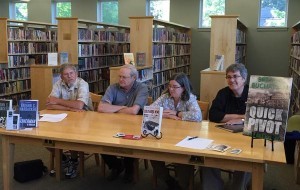
John Clark, Vaughn Hardacker, Maureen MIlliken and Brenda Buchanan talk mysteries, Maine and other stuff at the Thompson Library in Dover-Foxcroft July 14. (Diane Kenty picture)
On a much prettier typical Maine summer day two weeks ago, I made the drive up to the Thompson Library in Dover-Foxcroft, whereI and fellow contributors to this blog Brenda Buchanan and Vaughn Hardacker talked mysteries and writing to a small but appreciative audience, moderated by John Clark, who also contributes to this blog.
One of the questions to the panel concerned research, how we do it and what amount.
It’s a question I hadn’t given a lot of thought to, and my answer was that we’re always doing research. Since Cold Hard News and the upcoming novels in my Bernie O’Dea series are based near where I live and have a newspaper background, I can’t help but draw from what’s around me and what I experience on a daily basis as a newspaper editor. Aside from the usual Googling and looking things up that comes with writing, I thought that was it.
But I realized later that I’d left out a big aspect of my research: the interview.
I thought of this the other day when I finally sat down with a friend and colleague, Scott Monroe, who I’d been hounding for months to tell me about hunting, specifically about field dressing a deer in as much grisly detail as possible. I’m sure that’s info I could find on the internet, too, but there’s really nothing like talking it out with someone. Particularly when your interview victims are smart and insightful, which I always try to make mine are, it’s a goldmine. I’m sure now that my followup questions have already started and show no sign of letting up, he’s already regretting it.
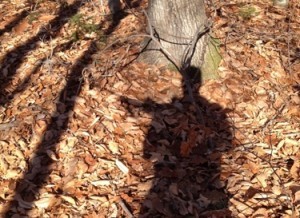
A possible piece of the cover art for the next Bernie O’Dea mystery novel, generously provided by Scott Monroe.
He’s also offered up some art that I hope will be part of the cover art of my upcoming novel, working name No News is Bad News. It’s a tradition, because he also supplied the photo that’s on the cover of Cold Hard News. Hopefully I won’t bug him so much about hunting that he takes it back.
Interviews were also a big part of Cold Hard News.
When I first started writing the book, I needed to talk to someone who was owner/editor of a weekly newspaper. Though I’d worked on dailies as a reporter, then an editor, since 1983, I knew enough about weeklies to know there was a lot I didn’t know. I was living in Manchester, N.H., at the time, and after a lot of research, found the right size paper with the right kind of owner/editor in Enosburg Falls, Vt. Ed Shamy had recently been laid off from the Burlington Free Press (this was 2009 and newspaper jobs were dropping like flies), had bought the County Courier in Enosburg Falls and was willing, though a little reluctantly, to talk to me. He said he wasn’t sure he could help me much and I said that’s okay, it’ll be painless and only take about half an hour.
Well, it ended up being nearly two hours and Ed not only gave me a lot of good detail about how a weekly operated, but also was candid and heartfelt about what it felt like to go from a big, influential daily to a little country weekly. That conversation formed the foundation Cold Hard News was built on.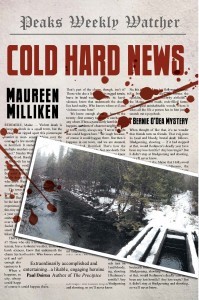
A while before that conversation, I had another one with my friend, reporter Lorna Colquhoun. Lorna, as a reporter for the New Hampshire Union Leader, had covered the Bruce McKay-Liko Kenney shootings in 2007 in Franconia, N.H. That double-fatal shooting inspired a dramatic turning point in my book.
A lot of what Lorna told me was deep background and detail that didn’t make it into the book, but I needed to have the conversation to fully understand what had happened, both the people and the events, so I could have fertilizer for my thought process.
In all three cases, I fully understood that I was going to get a lot of stuff that I wasn’t going to use. That didn’t matter and none of it was a waste of time. When I was a reporter, I used to approach interviews the same way. Sure, I had some questions jotted down, but I was just as focused on what the person I was interviewing could add that I wasn’t aware of, or hadn’t given a lot of thought to.
Those two conversations for Cold Hard News, and my recent and ongoing one that will help form a big part of the book in progress are big foundation ones. But both books also were formed out of probably hundreds of small conversations I’ve had with more people, about more topics, than I can remember.
I like to talk. I don’t deny it. Anyone who knows me will vouch for it. But I also think it’s becoming a lost art. Okay, not a lost art so much as dismissed as time-wasting or not productive. We love our electronic devices, and I’m thrilled that I can text, email and message people. In a lot of cases it’s more efficient and gets the job done. But none of those are as satisfying as good old-fashioned conversation.
Next time I’m asked about my mystery writing research I’ll keep that in mind.
And be sure to stop by the Belgrade Lakeside Artisan Show next Sunday, Aug. 2, where Vaughn Hardacker, Lea Wait and I will be manning the Meet the Maine Crime Writers table. It’s 9 a.m. to 3 p.m. at the Community Center for All Seasons on Route 27.
I’d love to chat!
Maureen Milliken is the author of Cold Hard News, the first book in the Bernie O’Dea mystery series.
July 24, 2015
Weekend Update: July 25-26, 2015
 Next week at Maine Crime Writers there will be posts by Maureen Milliken (Monday), Kate Flora (Tuesday), John Clark (Thursday) and Kaitlyn Dunnett/Kathy Lynn Emerson (Friday), with a guest blog on Wednesday.
Next week at Maine Crime Writers there will be posts by Maureen Milliken (Monday), Kate Flora (Tuesday), John Clark (Thursday) and Kaitlyn Dunnett/Kathy Lynn Emerson (Friday), with a guest blog on Wednesday.
In the news department, here’s what’s happening with some of us who blog regularly at Maine Crime Writers:
Today (July 25) several of us are at the Beyond the Sea Book Festival in Lincolnville Beach, Maine. Come join us if you can. Late morning and early afternoon is the best time to find us there, as we’re signing in overlapping shifts. Attendees include Barbara Ross, Dorothy Cannell, Lea Wait, Kate Flora, Susan Vaughan, and Kaitlyn Dunnett/Kathy Lynn Emerson. The complete schedule is here: http://www.beyondtheseamaine.com/book-festival-2015.html
Barb: On Thursday evening, July 30, at 6:30 I’ll be at the G.A.R. Memorial Library in West Newbury, MA, discussing “Not Your Ordinary Cozy Mystery” with fellow Wicked Cozy Authors, Jessie Crockett, Liz Mugavero and Edith Maxwell.
Lea: And, for next weekend, Sunday, August 2, Vaughn Hardacker, Maureen Milliken and I will be at the Belgrade Lakes Artisans Show, with our books, of course, from 9 am until 3 pm. A chance to talk with us … and take home a signed book (or three!)
An invitation to readers of this blog: Do you have news relating to Maine, Crime, or Writing? We’d love to hear from you. Just comment below to share.
And a reminder: If your library, school, or organization is looking for a speaker, we are often available to talk about the writing process, research, where we get our ideas, and other mysteries of the business. Contact Kate Flora: mailto: kateflora@gmail.com
July 23, 2015
Okay, But Seriously, What Should I DO? (About Book Promotion)
Hi All. Barb here. Finally back in Maine on a gorgeous summer day.
Back in the spring, I wrote a post called Four Lies Book Publicists Will Tell You about some of the false and outright damaging advice new writers get about marketing their books. In an effort to be more positive, I also wrote a post about Four Principles of Book Promotion. In that post, I explained the philosophical underpinnings of my approach.
A few people have written me and asked for more concrete advice. Philosophy is great and all, but the question is, what should I DO?
So I’ve come up with this timeline of what I think you should do. As always, there are caveats.
This is the opinion of one moderately successful, traditionally-published, mid-list writer, who has published four books. Read it through that filter.
This list is my advice about what you should do, wherever you are in the first book writing-publishing-publicity cycle now. If you are just starting your first draft, the actual activities further along in the cycle will have changed from the ones I list by the time you get there. Be flexible and be a learning animal. That’s part of the fun, right?
The to-do list is underpinned by my Book Promotion Principles, to wit:
Find Your Niche
Be A Person
Seek Safety in Numbers
Calm the Heck Down.
I am 100% sure there are multiple other approaches that will work.
Stage One To-Dos: As soon as you start a writing project that you seriously think might turn into a book
1. Join at least one, and maybe more organizations for writers. If you know what genre you’re working in, join organizations in that arena. If you’re working in crime writing, look at Sisters in Crime, Mystery Writers of America, and International Thriller Writers. If you’re working in Romance, join Romance Writers, etc. Be sure to also join the local chapters, even if you don’t live near the place where the meetings are held. Lots of local chapters have online groups and courses, as well as conferences that are worth traveling to. Also consider more general writing centers and groups in your geography. In Maine, Maine Writers and Publishers Alliance, in Mass., Grub Street, in NH, NH Writer’s Project, etc.
Comment: This can be a hard thing to do. For one thing, if you’re still working on that first draft, you may feel like a fraud and be intimidated. Don’t be. Everyone in the organization was once where you are now. Also, you may be reluctant because you’re already stealing time from your family and job to write your novel. Now, I’m advising you to steal more time. But believe me, it will be worth it to do this early. For one thing, you’ll have access to craft classes and other things that will make you a better writer and to psychological support that will keep you going. For another, it takes time to build a professional network and it may even take time to find the organization that is the right fit. So do it early. (Read Maureen Milliken’s excellent post about the value of community here.)
2. Reserve your domain name. Reserve the url with your name, or pseudonym if you already know you are going to use one. You can also reserve your protagonist’s name or your series name, but remember, these things may change. If you have a common name (like I do) get as close as you can. This is relatively cheap and easy.
3. If you don’t do so already, play around with social media. Try Facebook, Twitter, Pinterest, Instagram, Goodreads, etc. Don’t do it as an author. Do it as a person. Reconnect with cousins, classmates and former colleagues on Facebook. Follow people you admire on Twitter or Instagram. Create boards of pictures you love on Pinterest. Review the books you read on Goodreads. No agenda. Have fun. (Read Chris Holm’s excellent post on the Tao of Networking here.)
Comment: You will have a huge hill to climb once you sell your book. It will help if you are comfortable with some of the basic tools of book marketing. It will take time to figure out what you like and can sustain and to build a mental map of these services if you are not currently familiar with them. Of course, don’t spend all your time on social media. Writing the best book you are capable of is your most important job.
Stage Two To-Dos. When you’re rounding the turn to that third or fourth draft and you’re thinking, my gosh, this may be a book I can actually sell (or self-publish)
1) Remember those organizations I told you to join? Volunteer at one or more of them.
Comment: So, you’re already stealing time to finish your book, and I’m telling you to sink time into volunteer activities. Am I crazy? Hear me out. a) You’ll learn more about a whole lot of things, including the lives of working writers and the publishing industry, from the inside than from the outside. b) If possible, volunteer to do things that will expand skills you will need to develop anyway. Put out the group’s online newsletter (and learn how to use a program like Constant Contact or MailChimp). Work on the organization’s blog and learn WordPress or Blogger. If you learn WordPress, you’ll be able to create and maintain your own website. (There are other programs that make this easy, too.) Unless you work at a small company or are self-employed in your day job and do all your own marketing, it is unlikely you have all the skills you will need to market your book. Volunteering is a way to bring yourself up the learning curve, while having fun and making friends. And finally, c) You think you don’t have any time now? Just wait until you are a working writer with contract deadlines, book publicity, and let’s be realistic, probably still a day job. Pay your dues now.
2) Figure out what genre and subgenre you are writing in. Find blogs, Facebook groups, Goodreads groups, etc. dedicated to the genre or subgenre. Actively follow some of the leading lights in your field on Twitter or Instagram, and maybe some agents and publishers who publish your kind of book. Participate as a reader. Be a person.
3) Take a class. Go to a conference. I know it’s expensive, but focus on local to save on travel. Do your research to make sure it’s the right opportunity. (If it’s the right conference is a question you can ask that network of fellow writers you’ve been growing.) There’s not a single business you can get into without the investment of some capital, and that includes writing.
Note: At this point, the self-published and traditionally published paths diverge pretty dramatically. Since this post is already crazy long, I’m going to stick with traditional, since that’s the one I know most about.
Stage Three To-Dos: When you’ve started pitching agents and when you have an agent who has started submitting to publishers.
Comment: Okay this is where it gets murky. As I said in the previous posts, I don’t think an agent or publisher should judge a debut fiction author by the number of Twitter followers they have, or their web presence, or the size of their e-mail list. And as Jane Friedman commented on the earlier post, “Get a platform,” has become a gentle way for agents and publishers to say, “no.” (When I was raising venture capital for start-up businesses, we used to call this “Bring me the broom of the Wicked Witch of the West.” Quests you will be sent on that will only lead to more quests. Useful if they are things you should be doing anyway but otherwise, not.)
On the other hand, it is completely legitimate for an agent or publisher to want to be reassured that you are prepared to be a partner in supporting your book and that you have the skills necessary to do that.
1. So to that end, it may be useful to build a rudimentary author website at this point. Things you will do anyway in the process of preparing pitches–creating a log line, a query, a synopsis, a bio, etc–will come in handy in helping you shape content. Choose a look and feel for your website that says you understand your genre. Make sure the website provides a way to sign up for your e-mail newsletter.
2. Do whatever your agent tells you to do. Unless, of course, your agent is crazy and/or you feel he/she is using your lack of promotion as an excuse for why he/she can’t sell your book. In which case, drop your agent and move on. (Incredibly painful decision, I know.) But otherwise, do whatever your agent tells you.
Stage Four To-Dos: After your book has been sold to a publisher.
1. Three day party! Enjoy it before you have your inevitable meltdown about how you’ll never be able to make your book perfect, and you don’t know how to market it, and your mom is going to read your sex scenes.
In my experience, writers are terrible about enjoying their accomplishments. Don’t forget, this is what you’ve wanted for years.
2. Work with your publisher to fill out all all those marketing forms. Aren’t you glad you reserved your domain name way back in Stage One?
3. Get blurbs if this is your responsibility. (Remember that network you started on back in Stage One? Use that.) Plus approach some aspirationals. Your agent and/or publisher may be willing to help with this.
4. Once you have a cover, cover copy and blurbs, update your website and bring it into conformance with the look and feel and marketing positioning of your book.
5. As soon as your book is listed on Amazon and Goodreads, (which may be much earlier than you think) create an author page for each and “claim” your books. And probably do a Facebook author page at this point, too.
5. Get clear with your publisher’s publicist/marketing person who is doing what. Are they arranging a blog tour? Who are they submitting review copies too? Is your book going to be on NetGalley? Are they doing a Goodreads giveaway? You’re going to end up doing whatever they do not.
6. Get some tchotchkes. Bookmarks at a minimum. Decent stationery for cover notes for review copies (the ones that are hardcopy). Envelopes, shipping labels. All that stuff.
7. Get rid of every single Advanced Read Copy. Take one for sentimental reasons, and make sure the rest are gone. They’re not doing any good sitting in a box under your desk. Remember those book bloggers you identified in Stage Two? Where you’ve been participating as a person? Approach them. (Most will have review guidelines on their sites. Be respectful.) Do a Goodreads giveaway if your publisher isn’t going to.
8. Find some peers. Join a group blog or start one. (Not every one agrees with this advice, but it has been invaluable to me.) Find local authors (remember your network) who have books coming out at the same time as you. Set up some gigs at libraries, book stores, etc, with author friends. Remember, seek safety in numbers. Only 3 people may come to see not-yet-famous you, but if you have 3 friends and your friend has 3 friends, etc.
9. Plan your launch. Remember all those cousins, former colleagues and school friends you found on Facebook in Stage One? Make sure they know about your book and your launch. You’ve been living surrounded by people writing books, probably for years now, but to your non-writer friends, your first book launch is a big deal, particularly if they know it’s the culmination of a lifelong dream. You’ll be amazed at how many of them come out. Or just buy the book in their far-flung corner of the country. Or the world.
10. Send out an e-mail blast announcing your book, your appearances, your launch, include some early reviews, etc.
11. Try to relax and enjoy it. You love your book. You want to support your book. If you could, you would take a killer mortgage and move to a good school district so your book could have a better chance at a good college and a fulfilling life. But you can’t. You can only do what you can do. What happens from here depends on your book, your publisher and a little bit on you. You can only help so much, and you probably can’t screw it up.
Overwhelmed by this list? Don’t be. Some final pieces of advice.
Just focus on the tasks for the stage you are at now. Don’t worry about what’s coming next. By the time you get there, you’ll have more experience and a better foundation. What seems unthinkable now will be thinkable by then.
Don’t be freaked out by something you hate. If you would rather be killed than do an appearance at a bookstore, or if you hate, hate Facebook, skip it. Don’t let these hang ups prevent you from doing the other stuff.
You can always pay for stuff. This is a pretty DYI list. You can’t pay others to be you (or at least I think that rarely works on social media and never in person) but you can pay them to build websites or send e-mail newsletters or whatever.
So that’s all of what I know about my little corner of the universe today. Happily, the world is always changing and I am always learning, so I might have to do an entirely new list a year from now.
July 22, 2015
Walking
 Lea Wait, here, admitting there are a few downsides to being an author.
Lea Wait, here, admitting there are a few downsides to being an author.
One is that I spend most of my time (sometimes 8-12 hours a day) sitting and staring at a keyboard and screen. And getting up to stretch can lead to cups of tea and snacks. Or meals.
Last fall I knew I should do something about my weight — I weighed more than I ever had. But then snows were deep, the YMCA gym and pool half an hour away, and I had deadlines … and migraines.
My neurologist prescribed meds to help with the headaches, and I forged on. No one could help with the deadlines. (Yes: all manuscripts were in on time.)
 This spring, knowing my clothes-to-wear-in-public were a little tight, I was still shocked when my doctor told me I’d gained (gulp) twenty MORE pounds during the winter.
This spring, knowing my clothes-to-wear-in-public were a little tight, I was still shocked when my doctor told me I’d gained (gulp) twenty MORE pounds during the winter.
I got that news in the middle of a series of weeks I was speaking (sometimes in different states) several times a week. Dieting and exercise didn’t seem realistic. I had too much to juggle in my life already.
Then my headaches got worse. When I spoke with my neurologist again he mentioned, casually, that, well, those meds he’d put me on in December sometimes caused weight gain

Early 19th C stone wall
I threw out the rest of the bottle and by Memorial Day I was serious. I had to lose weight. A LOT of weight. I asked my Facebook friends about devices that counted steps, and ended up with a Garmin I love. It sets goals for me, counts my steps, and keeps track of my weight. Now, almost two months later, I walk 3-5 miles a day, am still counting calories, and have lost over ten pounds. Yes, I have a bad knee. Recovering from a walk requires an ice pack. But the pain is worth it. Slowly but surely I’m returning to a body

Graveyard, late 18th -early 19th C
I’m comfortable with. But I still have a long way to go.
Almost every day I walk down a road near my home that I’ve come to know well. It’s along the shore of a river, so houses on one side have waterfront. Houses on the other side have woods. And there are many acres of woods without homes.
I head down that road, not knowing what I’ll see. I’ve met deer. I found a perfect (dead) luna moth. Great blue herons hang out in one area. Neighbors who seem to work in their gardens no matter when I walk, greet me. When cars pass, we wave at each other. Even in parts of the road where woods are deep, I hear lobster boats working their traps, and pleasure boats speeding along. I’ve met most of the dogs who live along the road, and we’ve made peace with each other.
I’ve grown selfish about my walks. It’s my time to think. To plan. To listen to crows and bees and the rustle of squirrels and chipmunks in the woods. To plot my next chapter, or my next meal.
My Garmin nags me to make sure I walk at least 10,000 steps. When I started, I thought 5,000 steps was a good day. Now I miss my goal only on days when weather is really awful (when I walk on a treadmill, which is much more boring) or when I have a signing or book festival or other “away from home” event that takes most of the day.
Maine is a beautiful place. And walking in it is, yes, helping me get my body back to where it should be. But it’s also helping me focus more. There’s more to my world than a computer screen, and it’s good to be reminded of that. So, today, I’m taking you all along with me on my walk. All the pictures I’ve posted are scenes I pass along the way.
Welcome to my world.
Falling Into The Precipice
By Brenda Buchanan
Paul Doiron was in my doghouse last week. His newest Mike Bowditch novel, The Precipice, had me awake until well after midnight two nights in a row, and I’m a girl who needs her sleep. The book is so good I’m giving over my real estate here at Maine Crime Writers today to explain why I’ll be betting on it when 2015 award season rolls around.
First off, Dorion, a Maine Crime Writers blog alum, knows how to write the heck out of the Maine wilderness. He demonstrated that with his 2010 debut, The Poacher’s Son, which won a Barry and a Strand Critics Award for Best First Novel, and was nominated for a slew of others, including an Edgar. Readers hung on by their fingernails as Maine Game Warden Mike Bowditch took them deep into the Maine woods in an effort to prove his reprobate father was not responsible for murdering two men, one of them a state trooper.
Doiron followed up with Trespasser, Bad Little Falls, Massacre Pond and The Bone Orchard, each set in a different part of Maine because his protagonist’s reckless approach to his job had a tendency to irritate the hell out of his chain-of-command respecting bosses. In fact, by the time The Bone Orchard rolled around, Bowditch had resigned from the Warden Service, aware that he was one more headlong pursuit away from being fired. But when his longtime mentor was attacked and nearly killed, the impulsive warden realized his drive to be in the middle of the action didn’t go away when he turned in his badge. By the end of that book Bowditch was back in uniform, having realized the value of being a team player in a job that involves busting bad guys in Maine’s wildlands.
In The Precipice, Doiron shows us a more mature, confident Mike Bowditch, who is summoned along with all other available wardens to the North Woods when a pair of young, female Appalachian Trail thru-hikers disappears in the Hundred Mile Wilderness. The all-boots-on-the-ground call interrupts an idyllic getaway Bowditch hoped would impress his new girlfriend. He wears his disappointment on his sleeve. Her reaction is more muted. That turns out to be their ongoing relationship dynamic, but she’s not playing hard to get, she is hard to get.
Stacey Stevens is a wildlife biologist, pilot and wilderness first responder. The daughter of a retired warden pilot who has long been something of a father figure to Mike, Stacy is as comfortable as Mike in the outdoors. She can match him step for step when hiking a backwoods trail and identify birdsong and scat as fast as he can. In short, Stacey Stevens is Mike Bowditch’s dream woman, but she gives no consistent indication he is her dream man. In a lovely role reversal, a more seasoned Bowditch has mastered impulse control, and Stacey—at 30 a couple of years older than Mike—is the one prone to take crazy risks while trying to solve the case.
Doiron is particularly skilled at describing Maine in all of its beautiful, perilous seasons. The Precipice takes place in the fall, when AT thru hikers are finishing their long walk from Georgia. He provides the reader with a palpable sense of Maine’s wildness, and the very real dangers that are a fact of life in untamed areas of the state.
Having ascended Katahdin and several other of Baxter’s peaks before the cartilage in my knees got too old, my heart pounded with remembered fear when Mike struggled for footing on a rocky trail that a thunderstorm turned into a raging stream. Readers of The Precipice who’ve never spent time in the remote areas of Maine should heed this chilling passage:
I stopped in a sheltered crevice between two boulders and took a swig from my water bottle. I’d nearly drained both of the quart containers on my climb up Chairback. It felt strange to be soaked to the skin and yet so dehydrated at the same time. An hour earlier, I’d been on the verge of heat stroke; now I was goose-pimpled from the cold. Every warden has seen fatal cases of hypothermia in the middle of summer: swimmers who overestimate the warmth of a spring-fed pond, mountain climbers who wander into pouring rain above the treeline. All it takes is enough cold water to depress your body temperature ten degrees. There are so many ways a person can die in the woods.
In The Precipice, the hunt for the missing women is compelling. The characters are memorable. The tension is exquisite. Best of all, the reader is given an unmitigated opportunity to cheer for Mike Bowditch, who is turning into the kind of man he always had the potential to be.
Get your hands on a copy of The Precipice and be prepared for it to keep you reading deep into the night. It’s that good.
July 21, 2015
Don’t Ignore Local Venues
Vaughn Hardacker here: It’s been a month since the release of my second novel, THE FISHERMAN, and it’s been a struggle to schedule events at libraries throughout Aroostook County. My novel SNIPER was a finalist for a Maine Literary Award (along with  Kate Flora, Paul Doiron, and John Corrigan–writing as D. A. Keeley) and I sent mailings to a number of libraries through out Maine. My experience has been that library venues aren’t the best place to sell books. People go to the library to borrow books; not buy them. When I read in a local newspaper that John Corrigan was making a tour of Aroostook County with stops at libraries in Houlton, Presque Isle, and Caribou, I decided to attend the Caribou event so John would have at least one person in attendance. As it turned out, John told me that Caribou was the high point of the trip–in fact it paid for the trip. Rather than set up at the library itself, the Caribou Library arranged for him to have a vendor slot at Thursday on Sweden.
Kate Flora, Paul Doiron, and John Corrigan–writing as D. A. Keeley) and I sent mailings to a number of libraries through out Maine. My experience has been that library venues aren’t the best place to sell books. People go to the library to borrow books; not buy them. When I read in a local newspaper that John Corrigan was making a tour of Aroostook County with stops at libraries in Houlton, Presque Isle, and Caribou, I decided to attend the Caribou event so John would have at least one person in attendance. As it turned out, John told me that Caribou was the high point of the trip–in fact it paid for the trip. Rather than set up at the library itself, the Caribou Library arranged for him to have a vendor slot at Thursday on Sweden.
TOS is a bi-weekly venue held throughout the summer on Caribou’s main drag (Sweden Street) it features music (both via D. J. and live bands) as well as craft and food vendors. I located John and he told me that he’d sold more books that he had expected to sell. He also added, “This is the way to do it, rather than the library.”
When SNIPER was released I did a Caribou Library event and three people attended (one, an old friend from high school bought a book). This is the second year that TOS has been a 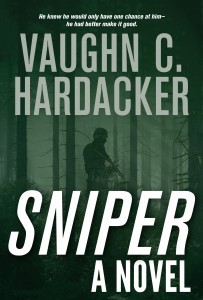 bi-weekly summer event in Caribou and I had not attended a single one. However, I took John’s advice and contacted the people in charge of the event and was told there was no fee for being a vendor all I had to do was submit a form available online. I did so and was assigned a spot for the rest of the summer.
bi-weekly summer event in Caribou and I had not attended a single one. However, I took John’s advice and contacted the people in charge of the event and was told there was no fee for being a vendor all I had to do was submit a form available online. I did so and was assigned a spot for the rest of the summer.
On July 2 I set up a table and boy was I surprised! Remember those three people who attended my SNIPER event? Here’s a picture of who attended TOS!
 After the first hour and a half I netted over a hundred dollars in sales!
After the first hour and a half I netted over a hundred dollars in sales!
Moral of this story…check out your local venues, they may be more lucrative than you ever thought and cost less.
July 19, 2015
First or Third?
 Kaitlyn Dunnett/Kathy Lynn Emerson here, reflecting on one of the choices writers need to make when they start work on a new novel. I am currently working on a proposal for a contemporary cozy series. I’m not ready to share much detail about character, setting, or plot just yet, but there is one aspect of the project that I can discuss—point of view.
Kaitlyn Dunnett/Kathy Lynn Emerson here, reflecting on one of the choices writers need to make when they start work on a new novel. I am currently working on a proposal for a contemporary cozy series. I’m not ready to share much detail about character, setting, or plot just yet, but there is one aspect of the project that I can discuss—point of view.
The majority of cozy mysteries are written in first person point of view and use a single narrator, usually a female. She is the amateur-detective protagonist and readers are in her mind, and her mind only, as she tries to solve a mystery. She’s essentially talking to the reader, telling us what happened to her. Every once in awhile, the first person narrator will be a “Watson” instead—the sidekick reporting on the protagonist’s actions. Once again, the reader will only see the story unfold through the narrator’s eyes.
The second most popular option is to use third person point of view. Instead of reading how “I” went about looking for clues, we follow the actions of the protagonist from the outside, although at times privy to her thoughts, as in “Liss MacCrimmon loved the sound of bagpipes. She just wished her husband felt the same.”
I’ve written novels in first person. I’ve also written novels in third person. In general, I prefer third person because it is more flexible. While some writers do limit themselves to one point of view, that isn’t a requirement. The story can be told from multiple viewpoints. There’s even something called omniscient viewpoint, which lets the author in on everything everyone is seeing and thinking. In romance novels, the usual practice is to use two points of view, the hero and the heroine. In many mystery novels, the use of four or five different point of view characters is not uncommon . . . except in cozies.
 In the Liss MacCrimmon series, the number of point of view characters depends on the plot. In the forthcoming (October 2015) The Scottie Barked at Midnight, I used only Liss’s point of view, but in the rest of the series I have scenes where I get into someone else’s head. This is especially useful when I want to let the reader in on something Liss couldn’t possibly be a witness to. In historical mysteries, it is even more useful to follow another character’s movements because men had access to places where women could not go. On occasion, I’ve even used the villain’s point of view.
In the Liss MacCrimmon series, the number of point of view characters depends on the plot. In the forthcoming (October 2015) The Scottie Barked at Midnight, I used only Liss’s point of view, but in the rest of the series I have scenes where I get into someone else’s head. This is especially useful when I want to let the reader in on something Liss couldn’t possibly be a witness to. In historical mysteries, it is even more useful to follow another character’s movements because men had access to places where women could not go. On occasion, I’ve even used the villain’s point of view.
Can you use more than one point of view character and still write in first person? Sure. But, at least in my opinion, it is harder to do so and still differentiate between characters. Mine all end up sounding alike. That’s less of a problem when I write in third person. It’s also possible to use both first person and third person in the same book. Joan Hess does this in her series featuring Arly Hanks. Arly’s point of view scenes are in first person. Scenes in the point of view of other characters are in third person.

one of the books I wrote in first person
I haven’t written all that many novels in first person. Of the non-mystery historical novels I wrote as Kate Emerson, some demanded multiple points of view. For those that did not, I chose to write in first person. One of the books I wrote for ages eight to twelve is in first person. The rest are in third. Similarly, with short stories, I’ve generally chosen third person, even though the length almost always dictates only one point of view.
For a time, I toyed with taking a secondary character who appears in The Scottie Barked at Midnight and making her the sleuth in a new cozy series. I experimented by using her as the detective in a couple of short stories. I wrote them both in first person. I’m not sure why. The novel she appeared in was written in third person.
That brings me back to this latest effort, the new series proposal. Which will it be—first or third? At the moment I’m inclined toward first person, in part because there’s going to be a lot of myself in the protagonist. She’s my age, for one thing. We speak the same language. So, at least for the section of text that will go with the proposal—the first fifty to a hundred pages—the plan is that “I” will tell the story. We’ll see how it goes.
And if I decide first person isn’t working? Thankfully, there’s an easy fix—just switch to third.
Lea Wait's Blog
- Lea Wait's profile
- 509 followers


![The+Precipice[1]](https://i.gr-assets.com/images/S/compressed.photo.goodreads.com/hostedimages/1437650867i/15608446.jpg)


